PUMA Bundle
How Does PUMA Dominate the Sportswear Game?
PUMA, a global sports powerhouse, has consistently outmaneuvered competitors with its dynamic sales and marketing strategies. From its iconic 'Forever Faster' campaign to its strategic product placements, PUMA has maintained a strong foothold in the ever-evolving sportswear industry. Founded in 1948, the company's journey from athletic performance to lifestyle dominance is a testament to its innovative approach. This article will explore the core elements that drive PUMA's success.
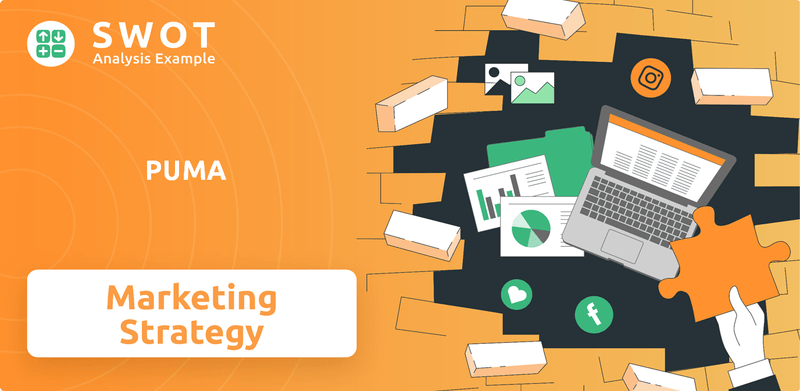
Diving deep into PUMA's PUMA SWOT Analysis reveals how the brand leverages its strengths and navigates weaknesses to stay ahead. This analysis will cover PUMA's sales and marketing plan, detailing its digital marketing strategy and social media strategy for sales. We'll examine PUMA's competitive analysis, including its PUMA brand positioning and PUMA target market, to understand how it fosters customer relationship management and achieves impressive sales performance indicators. The article will also explore PUMA's distribution channels and sustainable marketing initiatives.
How Does PUMA Reach Its Customers?
The sales strategy of the company involves a multifaceted approach, leveraging both online and offline channels to reach a wide customer base. This strategy, a key component of the overall PUMA business strategy, includes e-commerce platforms, the company's official website, physical retail locations, wholesale distributors, and strategic partnerships. The evolution of these channels reflects a strategic shift towards strengthening its direct-to-consumer (DTC) business.
In 2024, the company's direct-to-consumer (DTC) business, which includes its owned and operated retail stores and e-commerce, saw significant growth. This growth is supported by investments in warehouse and digital infrastructure. The company also focuses on strategic wholesale partners.
The company's global presence extends to over 120 countries, with a significant portion of its sales coming from Europe, the Middle East, and Africa (EMEA), the Americas, and Asia/Pacific. The opening of new flagship stores further underscores its commitment to connecting with consumers in key markets.
The company leverages its official website and various e-commerce platforms to reach customers. In 2024, e-commerce sales surged by 21.1% currency-adjusted. This growth is supported by investments in digital infrastructure.
The company operates physical retail locations, both owned and operated. Sales from owned and operated retail stores grew by 14.2% currency-adjusted in 2024. A new flagship store opened in Las Vegas in 2024.
The company utilizes wholesale distributors as part of its sales strategy. Wholesale business saw a modest increase of 0.4% currency-adjusted in 2024, reaching €6,391.8 million. The company focuses on strategic wholesale partners.
Strategic partnerships are crucial for the company's growth. The company aims to be the best partner for its strategic wholesale partners. The company's global presence extends to over 120 countries.
The company's PUMA sales strategy is characterized by a blend of digital and physical channels. The direct-to-consumer (DTC) business, encompassing retail stores and e-commerce, is a significant growth driver. The company's focus on strategic wholesale partners and global expansion further solidifies its market position.
- DTC business increased by 16.6% currency-adjusted to €2,425.4 million in 2024.
- E-commerce sales surged by 21.1% currency-adjusted in 2024.
- Wholesale business saw a modest increase of 0.4% currency-adjusted in 2024.
- The company operates in over 120 countries.
PUMA SWOT Analysis
- Complete SWOT Breakdown
- Fully Customizable
- Editable in Excel & Word
- Professional Formatting
- Investor-Ready Format
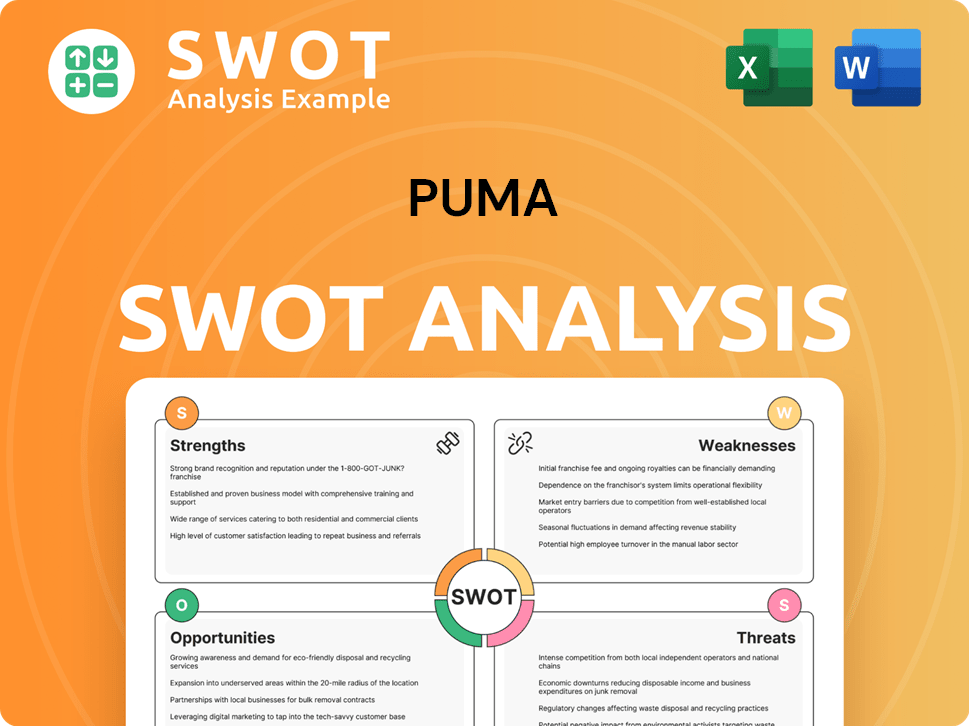
What Marketing Tactics Does PUMA Use?
The marketing tactics of the [Company Name] are designed to boost brand awareness, generate leads, and ultimately drive sales. This is achieved through a blend of digital and traditional media strategies. The company's approach is data-driven, focusing on customer segmentation and personalization to enhance the customer experience.
Digital marketing plays a crucial role in [Company Name]'s strategy, including content marketing, SEO, paid advertising, and email marketing. A significant aspect of their digital presence is influencer marketing and social media campaigns. These efforts are designed to engage audiences and create interactive experiences.
Traditional marketing methods, such as TV, radio, print, and events, are still part of the marketing mix. The company also focuses on data-driven marketing, customer segmentation, and personalization to improve marketing effectiveness. Their marketing strategy has evolved, including relocating the marketing function and restructuring marketing efforts.
The company utilizes content marketing and SEO to enhance its online visibility. Paid advertising and email marketing are also key components of their digital strategy. Effective social media campaigns are used to engage with audiences.
Influencer marketing is a core element of [Company Name]'s global branding. They build long-term relationships with global ambassadors and local influencers. This strategy focuses on 'influencing the influencers' to generate organic hype.
Traditional marketing includes TV, radio, print, and events to reach a broad audience. These methods complement digital strategies for a comprehensive marketing approach. Data-driven insights inform the selection of traditional marketing channels.
The company emphasizes data-driven marketing, customer segmentation, and personalization. This approach allows for targeted campaigns and improved customer engagement. Data analysis helps in refining the Growth Strategy of PUMA.
The company allocates approximately 60% of its marketing investment to brand investment and 40% to conversion or short-term channels. In 2025, marketing investment is planned to be around 10% of sales. The 'Go Wild' campaign will see a 40% increase in investment over 2024 levels.
The company partners with global ambassadors and local influencers to boost brand visibility. Some of the key influencers include K-pop sensation Rosé, artist and designer A$AP Rocky, Rihanna, and LaMelo Ball. These partnerships enhance brand credibility.
The company's marketing tactics are multifaceted, incorporating digital and traditional methods. The focus is on building brand awareness, engaging with the target market, and driving sales through strategic campaigns. These tactics are supported by data analytics to measure effectiveness.
- Content Marketing: Creating valuable content to attract and engage the target audience.
- SEO: Optimizing content and website structure to improve search engine rankings.
- Paid Advertising: Utilizing platforms like Google Ads and social media ads to reach a wider audience.
- Email Marketing: Sending targeted emails to nurture leads and promote products.
- Influencer Partnerships: Collaborating with influencers to increase brand visibility and credibility.
- Social Media Campaigns: Developing creative and interactive campaigns to engage with audiences.
- Traditional Media: Utilizing TV, radio, print, and events to reach a broader demographic.
- Data-Driven Marketing: Using customer data to personalize marketing efforts and improve ROI.
- Customer Segmentation: Dividing the market into segments to tailor marketing messages.
- Personalization: Customizing marketing messages and offers based on customer behavior.
PUMA PESTLE Analysis
- Covers All 6 PESTLE Categories
- No Research Needed – Save Hours of Work
- Built by Experts, Trusted by Consultants
- Instant Download, Ready to Use
- 100% Editable, Fully Customizable
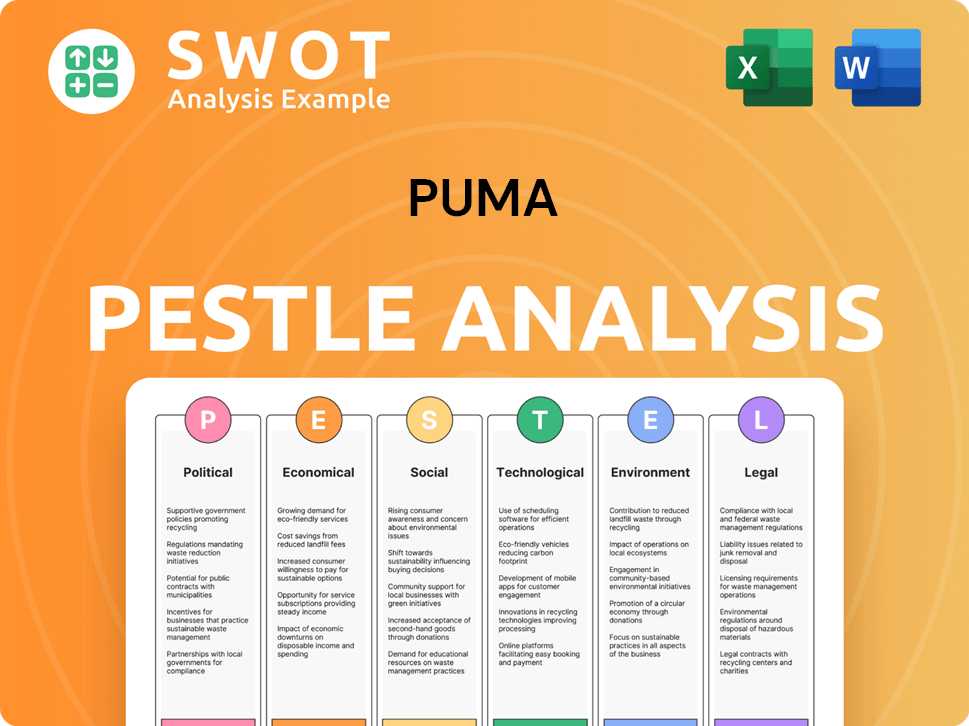
How Is PUMA Positioned in the Market?
The brand positioning of the company revolves around its 'Forever Faster' ethos, emphasizing speed, performance, and a strong sports heritage. This differentiates the company from competitors by focusing on innovation and cultural relevance. The company aims to be at the forefront of trends, influencing both product development and marketing strategies to resonate with its target audience.
The company's approach involves challenging conventions and supporting visionary athletes and cultural figures. This focus allows it to connect with consumers through authentic storytelling and a dynamic brand identity. The company's marketing efforts are designed to reflect this spirit, ensuring consistency across all channels and touchpoints.
The company primarily targets Gen Z and millennials, recognizing them as key influencers. It connects with these demographics through culturally relevant collaborations and a focus on sport as a form of self-expression. This strategy helps the company to carve a niche in the market, especially within the urban fashion segment, and allows for a unique competitive analysis.
The core of the company's brand identity is its 'Forever Faster' mission. This emphasizes speed, performance, and a strong sports DNA. This positioning helps the company stand out in a competitive market.
The company primarily targets Gen Z and millennials. These demographics are key influencers in shaping global trends. This focus allows the company to tailor its marketing efforts effectively.
Brand consistency is maintained across all channels and touchpoints. The 'brand elevation strategy,' implemented in 2024, aims to strengthen brand perception and improve distribution quality. This is a key part of the overall
The company actively responds to shifts in consumer sentiment, particularly regarding sustainability. The 'FOREVER. BETTER.' sustainability strategy integrates sustainability into all core business functions. This demonstrates the company's commitment to environmental responsibility.
The company's brand elevation strategy is designed to drive long-term growth and market share. This involves establishing a distinctive brand DNA and strengthening performance credibility. The company's YouGov BrandIndex score improved from 12.4 in April 2023 to 18, indicating positive shifts in brand perception. This shows the effectiveness of the
- Brand Elevation Strategy: Focuses on strengthening brand perception and improving distribution.
- Sustainability Strategy: 'FOREVER. BETTER.' integrates sustainability into core business functions.
- Target Demographic: Primarily Gen Z and millennials.
- YouGov BrandIndex: Improved from 12.4 to 18, reflecting positive brand perception.
PUMA Business Model Canvas
- Complete 9-Block Business Model Canvas
- Effortlessly Communicate Your Business Strategy
- Investor-Ready BMC Format
- 100% Editable and Customizable
- Clear and Structured Layout
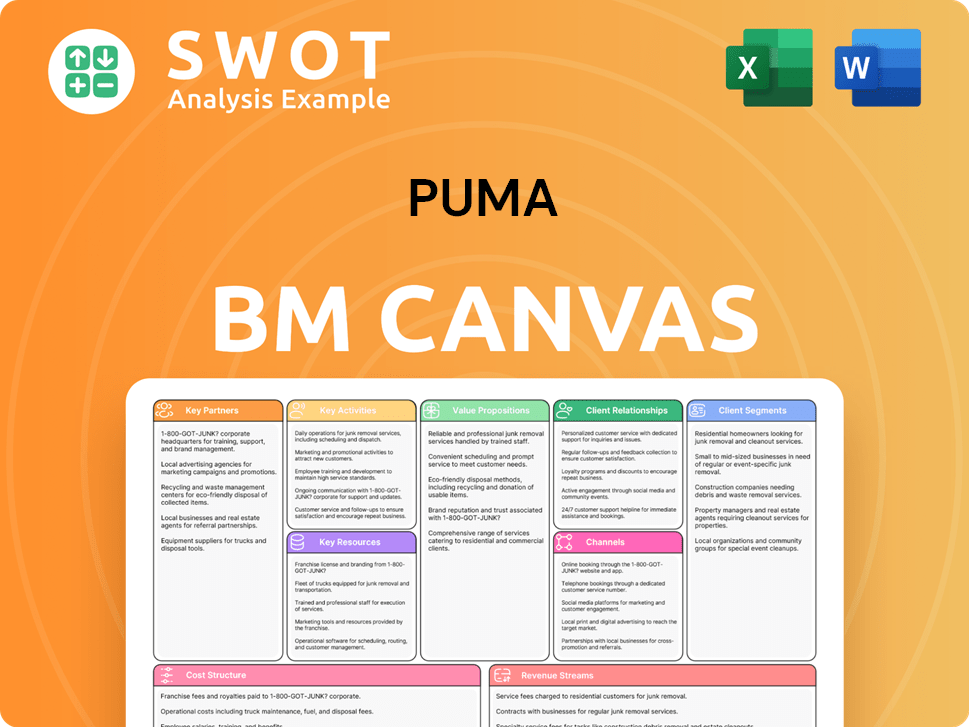
What Are PUMA’s Most Notable Campaigns?
PUMA's sales and marketing strategy is significantly shaped by its key campaigns, which are designed to boost brand visibility and drive sales. These campaigns are carefully crafted to resonate with the PUMA target market and enhance its brand image. The company’s approach involves a mix of global initiatives and localized efforts, ensuring relevance across diverse markets.
One of the most impactful campaigns is 'Forever Faster,' which is central to PUMA's brand identity. This campaign emphasizes speed, performance, and style, contributing to increased brand awareness and sales over time. In addition to 'Forever Faster,' PUMA consistently launches new campaigns to stay relevant and capture consumer attention.
PUMA's comprehensive approach to marketing includes various strategies, from digital marketing to social media engagement, and product placement. The company's commitment to innovation in its marketing efforts is evident in its campaigns. To understand more about the company's origin, check out the Brief History of PUMA.
Launched in April 2024, this campaign marked a significant shift in PUMA's brand identity. It aimed to strengthen consumer connections and increase brand visibility. The campaign was supported by major events like the Olympic Games and Euro 2024, contributing to increased brand awareness, especially in the US.
This campaign focuses on female empowerment and has been widely praised for its positive impact. PUMA's commitment to supporting women is a key element of their marketing strategy. The campaign resonates with women globally, reinforcing the brand's values.
PUMA actively partners with influencers and celebrities to boost brand visibility. Collaborations with global ambassadors like Rihanna and A$AP Rocky are common. Local influencers, such as K-pop sensation Rosé, are also used to promote specific products.
The return of the Speedcat, with 11,000 pairs seeded to cultural insiders before its 2024 launch, exemplifies PUMA's strategy. This approach generates organic hype through influencer marketing. This strategy helps create demand and excitement around new products.
PUMA's marketing campaigns are characterized by several key components that contribute to their success and effectiveness. These elements are essential for driving sales and strengthening brand loyalty.
- Brand Identity: Campaigns consistently reinforce PUMA's core values and brand identity.
- Targeted Messaging: Campaigns are designed to resonate with specific consumer segments.
- Influencer Marketing: Collaborations with relevant personalities are a core strategy.
- Event Sponsorship: Leveraging global sporting events to amplify campaign reach.
PUMA Porter's Five Forces Analysis
- Covers All 5 Competitive Forces in Detail
- Structured for Consultants, Students, and Founders
- 100% Editable in Microsoft Word & Excel
- Instant Digital Download – Use Immediately
- Compatible with Mac & PC – Fully Unlocked
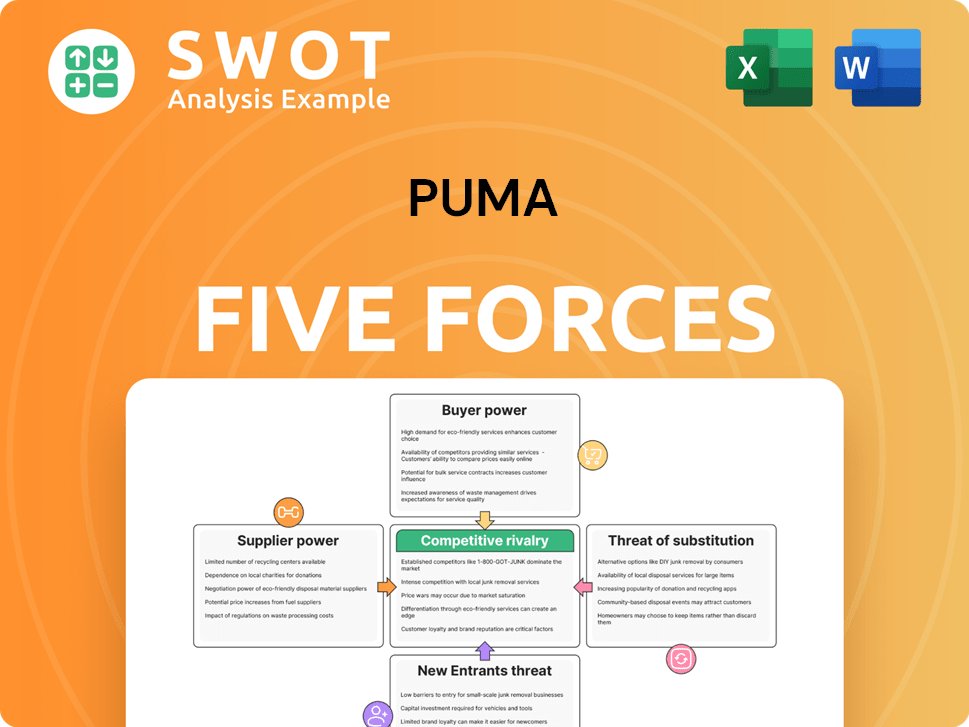
Related Blogs
- What are Mission Vision & Core Values of PUMA Company?
- What is Competitive Landscape of PUMA Company?
- What is Growth Strategy and Future Prospects of PUMA Company?
- How Does PUMA Company Work?
- What is Brief History of PUMA Company?
- Who Owns PUMA Company?
- What is Customer Demographics and Target Market of PUMA Company?
Disclaimer
All information, articles, and product details provided on this website are for general informational and educational purposes only. We do not claim any ownership over, nor do we intend to infringe upon, any trademarks, copyrights, logos, brand names, or other intellectual property mentioned or depicted on this site. Such intellectual property remains the property of its respective owners, and any references here are made solely for identification or informational purposes, without implying any affiliation, endorsement, or partnership.
We make no representations or warranties, express or implied, regarding the accuracy, completeness, or suitability of any content or products presented. Nothing on this website should be construed as legal, tax, investment, financial, medical, or other professional advice. In addition, no part of this site—including articles or product references—constitutes a solicitation, recommendation, endorsement, advertisement, or offer to buy or sell any securities, franchises, or other financial instruments, particularly in jurisdictions where such activity would be unlawful.
All content is of a general nature and may not address the specific circumstances of any individual or entity. It is not a substitute for professional advice or services. Any actions you take based on the information provided here are strictly at your own risk. You accept full responsibility for any decisions or outcomes arising from your use of this website and agree to release us from any liability in connection with your use of, or reliance upon, the content or products found herein.